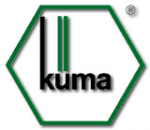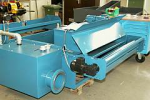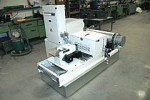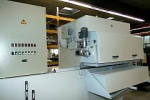230.206
Kuma Hydrocyclones
Hydrocyclone Cooling Lubricant -- cleaning systems operate in all applications where heavy dirt particles are to be separated from low viscous liquids -- e.g. on machine tools (especially grinding machines), but also on machining stations, transfer lines and parts washing plants.
Hydrocyclone Cooling Lubricant – cleaning systems operate in all applications where heavy dirt particles are to be separated from low viscous liquids – e.g. on machine tools (especially grinding machines), but also on machining stations, transfer lines and parts washing plants.
FunctionThe liquid to be purified flows into the cylindrical part of the hydrocyclone via an admission spiral at a pressure of 2.2 bar. The tangential arrangement of the inlet and the high flow speed provoke the creation of a quickly rotating whirl, the rotational speed of which increases continually in relation to the cone housing being steadily reduced in diameter. The high rotational speeds create substantial centrifugal forces which act on the dirt particles. The dirt particles are thus pressed against the walls of the cyclone and discharged through the underflow nozzle together with a small quantity of liquid. The flow resistance increases as the cross section in the cone housing narrows. This reverses the running direction of the primary whirl in the lower part of the cyclone.
This secondary whirl runs upwards, maintaining its direction through the immersion tube, into the clean water chamber. (The secondary whirl has an air core that ventilates the coolant and therefore has a rot-preventing effect.)
Structure • Centrifugal separator
• Wear-resistant plastic housing
• Easily replaceable components
Advantages • High cleansing efficiency (approx. 98% related to one effective separating size > lO(.Jm)
• No recurring costs for filter elements
• Can be used for magnetic and nonmagnetic particles
• No deterioration of the cooling lubricant
• Steady ventilation of the cooling lubricant, therefore long service life of the lubricant
• Reliable operation thanks to a simple functional principle
• Low maintenance requirements
For more information regarding this item (Kuma Hydrocyclones) or other items, fill out the form below
or contact our office directly:
Telephone: 815-962-5600
Fax: 815-962-4600
Location: 304 North Main St, Suite 104, Rockford, IL 61101-1101 USA
Email: infο@ΤΑCRοckfοrd.cοm
Related
Vacuum Band Filters
Continuous purification of soiled cooling lubricants, as they are produced when operating machine tools. Purification of liquids from industrial washing plants and dust extraction plants and systems. It makes sense to use such a Vacuum Band filter with high throughput rates, because the throughput in a Vacuum Band Filter is 3 to 4 times higher than in a Gravitation Band Filter while the filtration area is identical. The Vacuum Band Filter consumes less filtration material.
Automatic Filter Devices
The soiled cooling lubricant is conveyed onto the non-woven filter lying in a cavity, via a liquid feed distributor. Owing to the gravitational force the coolant flows through the non-woven filter into a liquid container beneath the band filter. The dirt particles contained in the cooling lubricant are filtered out by the non-woven filter and accumulate in the form of a sludge cake on it. This causes a reduction of the permeability of the filter paper and, therefore, an increase of the liquid level above the filter cavity.
Internal Bed Filters
This type of filter can be used in all treatments where small chips and fine particles are to be filtered out of liquids even if these are of a rather high viscosity. This type of filter has proved its worth and efficiency not only in machining stations, but also in grinding machines, honing machines and wash water conditioning. This filter can be used as an individual system, but also for supplying several machines simultaneously.





